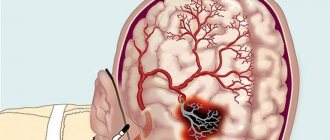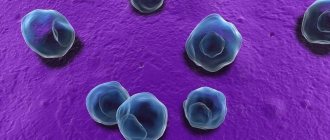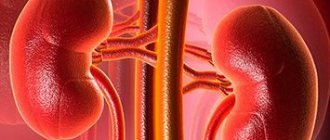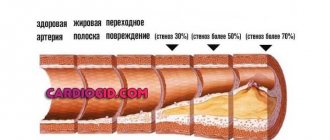Last update: 01/14/2020
Vitamin A is a substance that plays an extremely important role in the life of epithelial (skin) cells, physiological processes accompanying the functioning of the organs of vision, protein and cholesterol synthesis, and the functioning of the body's defenses. There are two main ways to obtain the vitamin - absorption through food of animal origin and synthesis within the intestinal mucosa, which involves carotenes (plant pigments). For example, beta-carotene, found in large quantities in carrots, is an important source of vitamin A.
In the body, vitamin A is deposited (stored) mainly in the tissues of the liver, retina, brain, and ovaries. It should be noted that in many healthy people, the total amount of vitamin A in the body may be greater than the annual requirement for it, so obvious symptoms of vitamin A hypovitaminosis may be absent for a long time. This also explains why in developed countries, where the majority of the population has access to a varied diet with plenty of animal foods, vitamin A deficiency is relatively rare. At the same time, this disorder is extremely common in many African, Asian, and Latin American countries. Some researchers consider vitamin A deficiency to be one of the main causes of blindness and child mortality in developing countries.
Classification
The clinical forms of the disease are systematized taking into account its causes and the degree of retinol deficiency. Depending on the origin, the deficiency is more often acquired and less often hereditary. Taking into account the leading etiological factor, a distinction is made between primary retinol deficiency caused by malnutrition and secondary deficiency caused by another pathology. Based on the severity of symptoms, experts in the field of modern gastroenterology and dietetics distinguish 3 stages of vitamin deficiency:
- Stage I (prehypovitaminosis A). A decrease in retinol levels can only be determined in a laboratory. There are no clinical symptoms. To correct the condition, it is enough to enrich your diet with foods containing vitamins.
- Stage II (hypovitaminosis A). It has an uncomplicated course, mainly with ophthalmological and dermatological symptoms, and mild immunodeficiency. Oral retinol is recommended.
- Stage III (vitaminosis A). Against the background of a significant retinol deficiency, multiple organ disorders occur. A complicated course is typical. To compensate for deficiency, vitamin A is administered parenterally.
Why do we need “carrot vitamin”?
Having discovered the substance, biochemists carefully studied its properties and came to the conclusion that the product, obtained in the laboratory, has an anti-infective and anti-xerophthalmic effect.
With the help of vitamin A, cell membranes are formed, which means it is present in every cell of our body. It is also responsible for the process of protein synthesis and influences our growth. Providing the process of regeneration of mucous tissues and epithelium, it participates in the production of necessary enzymes and hormones. Vitamin A, with its powerful antioxidant properties, prevents the destructive effects of free radicals.
Causes of vitamin A deficiency
The level of vitamin A in newborns is low, but in the first days of life it quickly increases due to intake with colostrum, breast milk, and adapted formulas. In healthy children and adults who are on a balanced diet, the risk of developing hypo- and vitamin A deficiency is low. What leads to the pathological condition?
- A diet deficient in foods rich in vitamin A. Minimizing milk, vegetables, fruits, butter, eggs, liver, and fats in the diet can lead to deficiency;
- Being on parenteral nutrition;
- Low intake of protein foods. Leads to a lack of protein - a vitamin carrier;
- Impaired absorption of retinol in the intestine with: celiac disease, celiac disease, cholecystitis, spastic colitis, Crohn's disease, diseases of the liver, pancreas, intestines, anemia, alcoholism, cholestasis, disseminated tuberculosis, long-term use of mineral oil;
- Loss of vitamin by the body due to: cancer, chronic infections, urinary tract diseases;
- Conditions in which intensive consumption of vitamin A occurs: rapid growth and development, pregnancy, lactation, increased physical and mental stress, stress.
Consequences and complications
Complications depend on which vitamin is missing in the body.
- With chronic vitamin A deficiency, vision can be affected - it decreases, and eye diseases develop.
- Vitamin C deficiency leads to the development of immune disorders. There is a risk of developing scurvy.
- Vitamin D deficiency leads to rickets, dental diseases, and fractures. , diabetes mellitus and hypertension can develop .
- In addition, diseases of the gastrointestinal tract, deterioration of skin condition, and frequent infectious diseases can develop as complications of vitamin deficiency.
Avitaminosis, hypovitaminosis and hypervitaminosis
Vitamin deficiency is the absence of any vitamin or several vitamins (polyavitaminosis). It happens due to malnutrition or disruption of the functioning of organs related to digestion. It may also be a consequence of metabolic characteristics in childhood and old age. Vitamin deficiency causes diseases such as rickets (lack of vitamin D), scurvy (lack of vitamin C) and others. But a complete lack of vitamins is rare; hypovitaminosis is more common.
Hypovitaminosis is a lack of vitamins. With a lack of vitamins, performance decreases, appetite worsens and immunity weakens. Irritability and constant fatigue appear. If you do not increase your intake of vitamins, then the body will not be able to properly absorb and extract useful substances from incoming food, as a result the condition of tissues (skin, muscles, mucous membranes) and body functions (growth, intellectual and physical development) will begin to deteriorate. At the same time, hypovitaminosis may not particularly manifest itself and last for years, causing harm to health.
Let's say a lack of vitamin A impairs twilight vision (night blindness), a lack of vitamin B1 disrupts the oxidation of carbohydrates, there is a decrease in appetite, weakened memory, and headaches. Hypovitaminosis B2 disrupts energy and metabolic processes. A lack of vitamin C is manifested by peeling skin, bleeding gums, weakness and irritability, and pain in the legs. A lack of vitamin E contributes to muscular dystrophy.
The risk group includes people who abuse alcohol and tobacco, women during pregnancy and during breastfeeding, children and the elderly. Vegetarians and lovers of strict diets, people whose lives are associated with increased mental and physical stress.
Hypervitaminosis is an excess of vitamins. With an excess of one or more vitamins, often fat-soluble, as they accumulate, the body becomes intoxicated with an ultra-high dose of vitamins, which leads to various disturbances in the functioning of the body. With an excess of vitamin A, liver function is disrupted, blood pressure rises, loss of strength, drowsiness and headaches are observed. An overdose of vitamin C can cause insomnia and disruption of the pancreas and kidneys. Vitamin D may contribute to the formation of kidney stones and bone destruction. Often symptoms of excess vitamin D include poor appetite, weight loss, weakness, nausea, abdominal pain and constipation, and headache in the back of the head. Excess vitamin E causes fatigue, weakness, and dizziness. It may manifest itself in disorders of the gastrointestinal tract and unstable functioning of the cardiovascular system.
More on the topic:
- Gymnastics – ancient Greek physical education
- Vitamin D – how much is it in grams?
- 5 tips to overcome a plateau
- Homemade dumbbells
- Products that will help remove nicotine from the body
Category: Articles
Daily consumption rate
To avoid vitamin A hypovitaminosis, it is necessary to ensure sufficient intake of this substance from food. The norm depends on age and physiological characteristics (pregnancy, menopause, period of active growth in children):
| Group | Norm |
| children under three years old | 300 mcg |
| 4-8 years | 400 mcg |
| 9-13 years | 600 mcg |
| teenage boys and men | 900 mcg |
| teenage girls and women | 700 mcg |
The norm for teenagers and adults is the same. Women during pregnancy need 800 mcg of retinol per day; during lactation, the consumption rate increases to 1100 mcg.
The maximum allowable daily amount of retinol is 3000 mcg. Such large doses are used in the treatment of diseases caused by vitamin A deficiency.
UNIT CONVERTER: VITAMIN A
Form of substance
Decimal places as a result
Convert
Conversion of IU ⇄ g/mg/mcg (developed by pharmacists and doctors based on reliable data)
Online consultations with doctors
| Consultation with an andrologist-urologist |
| Consultation with a pediatric gastroenterologist |
| Consultation with a treatment specialist abroad |
| Consultation with a dermatologist |
| Dentist consultation |
| Consultation with a pediatric neurologist |
| Consultation with an otorhinolaryngologist |
| Pediatrician consultation |
| Consultation with a diagnostician (laboratory, radiological, clinical diagnostics) |
| Consultation with a laser cosmetology specialist |
| Consultation with a neuropsychiatrist |
| Consultation with a specialist in the field of stem cell treatment |
| Consultation with a child psychologist |
| Consultation with an orthopedist-traumatologist |
| Psychiatrist consultation |
Medical news
Football fans are in mortal danger, 01/31/2020
“Smart glove” returns grip strength to victims of injuries and strokes, 01/28/2020
An easy way to improve health has been named, 01/20/2020
Top 5 massage salons in Kyiv according to Purchase, 01/15/2020
Health news
The head of WHO declared a pandemic COVID-19, 03/12/2020
Coronavirus has already attacked more than 100 countries, almost 120,000 people have been infected, 03/11/2020
Coronavirus has attacked 79 countries, the number of victims is approaching 3,200 people, 03/04/2020
The new coronavirus has attacked 48 countries of the world, the number of victims is growing, 02/27/2020
Medicines
For clinically apparent vitamin A deficiency, treatment is limited to daily oral vitamin A supplements.
Vitamin A overdose can cause symptoms and signs such as:
- roughening of the skin
- dry hair
- liver enlargement
- increased erythrocyte sedimentation rate, increased serum calcium and alkaline phosphatase concentrations
Given evidence that high levels of vitamin A can cause birth defects, taking vitamin A supplements (including fish oil supplements) is not recommended for pregnant women or women who may become pregnant. They are also advised not to consume liver or foods such as liver pate or liverwurst unless directed by a doctor.
If the patient seeks medical help when the deficiency is subclinical, the prognosis is good. As blindness progresses, the prognosis worsens. Irreversible conditions include punctate keratopathy, keratomalacia, and corneal perforation.
- For patients with early, mild eye problems, prompt treatment can result in complete preservation of vision without residual impairment (complete recovery within a few weeks).
- In developing countries, severe vitamin A deficiency, often caused by significant malnutrition, leads to death in most cases. The mortality rate in children with severe vitamin A deficiency is up to 50%.
- Only about 40% of patients with corneal xerophthalmia continue to see a year later (25% are completely blind and the rest are partially blind).
Prevention
To prevent hypovitaminosis, it is recommended to buy vegetables and fruits from domestic farmers after checking for the presence of harmful substances. It is better to transport them in a wooden container. In this case, vitamins are subject to slow decay.
Proper cooking is also required. Vegetables should be thrown into boiling water, to which salt has already been added. Proper cooking allows you to preserve most of the vitamins.
In spring and autumn, take preventive vitamin complexes. They contain the daily dose of essential substances. Drug prophylaxis is needed in case of reliably suffered hypovitaminosis. In this case, the drugs are prescribed twice a year in small doses.
Video program about hypovitaminosis:
Other diseases
- Adenoviral conjunctivitis
- Allergic diseases of the eyelids
- Amblyopia
- Anomalies of eyelid position
- Developmental anomalies of the eyelids
- Corneal developmental abnormalities
- Anomalies in the development of the lacrimal glands and lacrimal ducts
- Aplasia of the lacrimal gland
- Astigmatism
- Optic atrophy
- Bacterial diseases of the eyelids
- Blepharitis
- Myopia
- Viral diseases of the eyelids
- Viral conjunctivitis
- Inflammation of the cornea
- Inflammatory diseases of the lacrimal organs
- Congenital neoplasms of the eyelids
- Hemangiomas of the eyelids
- Hypertrophy of the lacrimal gland
- Hypoplasia of the lacrimal gland
- Glaucoma
- Purulent conjunctivitis
- Gonoblenorrhea
- Dacryoadenitis
- Dacryocystitis
- Farsightedness
- Dermoid eyelid
- Diabetic retinopathy
- Macular degeneration
- Corneal dystrophy
- Retinal diseases
- Malignant neoplasms of the eyelids
- Visual computer syndrome
- Foreign body of the eye
- Foreign body of the eyeball
- Iridocyclitis
- Iritis
- Lacrimal gland carcinoma
- Cataract
- Keratoglobus
- Keratoconus
- Conjunctivitis caused by toxic substances
- Conjunctivitis
- Strabismus
- Macular degeneration
- Megalocornea
- Optic neuritis
- Eye burn
- Retinal pigmentary dystrophy
- Mechanical, thermal or chemical damage to the eye
- Creeping corneal ulcer
- Presbyopia
- Acquired eyelid neoplasms
- Strandberg-Grönblad syndrome
- Dry eye syndrome
- Senile retinal dystrophy
- Point retinal dystrophy
- Eye injury
- Uveitis
- Cellulitis of the lacrimal sac
- Photokeratitis
- Chorioretinitis
- Embryotoxon
Signs and symptoms of vitamin A deficiency
Impaired twilight vision is one of the signs
The first symptoms usually manifest themselves in the form of a visual disorder - hemeralopia, when there is a deterioration in the perception of light at dusk, the so-called “night blindness”. Subsequently, xerophthalmia develops - drying of the conjunctiva and cornea of the eye. The formation of inflammatory processes on the mucous membrane of the eye is possible - conjunctivitis, chronic inflammation of the edges of the eyelids - blepharitis.
Primary signs also include disturbances in the structure of nails, hair, and skin. Drying and hair loss, splitting of nails, peeling of the skin and the formation of dermatitis, and the appearance of wrinkles are observed. Excessive dryness of the skin is accompanied by the addition of various infections, ulcers and plaques form.
Retinol deficiency provokes a significant decrease in the body's resistance to infectious infections, primarily affecting the upper respiratory tract, as well as the kidneys, bladder, and gastrointestinal tract.
When retinol deficiency develops, the sense of smell decreases and erectile function may be impaired in men.
If the dosage is exceeded
With independent, uncontrolled use of the substance, symptoms of vitamin A hypervitaminosis .
Hypervitaminosis in chronic form is complemented by soft tissue compactions that acquire a yellowish color. Typically, vision with hypervitaminosis undergoes changes. As a rule, double vision appears and body weight decreases noticeably. An endocrinologist accurately confirms the diagnosis of vitamin A hypervitaminosis by analyzing the results of an ultrasound scan of the liver and other organs.
It is also worth remembering that vitamin A obtained from fresh fruits and vegetables should not be ingested in dangerous quantities. At the same time, vitamin A taken into the body in the form of tablets should not exceed the daily requirement. Otherwise, it can be very harmful and even fatal. In case of hypervitaminosis, vitamin A intake should be supervised by a doctor.
Vitamin D deficiency
Vitamin D is a member of the group of fat-soluble vitamins and is formed directly in the skin under the influence of UV radiation, and also enters the body with food.
Vitamin D deficiency increases the risk of late gestosis in pregnant women (preeclampsia), leads to osteoporosis (see symptoms and causes of osteoporosis), reduces muscle strength, and is one of the provoking factors of diabetes mellitus and the development of oncology.
A study conducted by Manchester specialists, using an example of 2,300 men, determined that men with a lack of vitamin D suffered from general chronic pain (which was associated with neurological disorders or rheumatism) 2 times more often than people with normal and high concentrations of vitamin D.
Typically, men with vitamin D deficiency are obese, lead an inactive lifestyle, and suffer from depression and other neurological disorders.
| Symptoms | Symptoms in children of hypovitaminosis and vitamin D deficiency are the clinical picture of rickets, the onset of which occurs 2-3 months after birth (see rickets in infants: signs, treatment):
In adults, hypovitaminosis D is manifested by increased fatigue, muscle weakness, insomnia, burning in the mouth and throat, decreased appetite and weight loss, muscle cramps in the legs and arms, frequent fractures and cracks of bones due to osteomalacia. |
| Diagnostics | Diagnosis is based on the visible clinical picture of osteomalacia and rickets, as well as X-ray data: signs of osteoporosis and osteomalacia of bones, hyperplasia of osteoid tissue. |
| Treatment | For infants, it is preferable to breastfeed or switch to adapted milk formulas. Complementary foods are introduced a month ahead of schedule. For adults, it is necessary to enrich the diet with fish oil, egg yolk, liver, butter, and meat. Drug therapy To treat vitamin D deficiency, oral synthetic analogues of this vitamin are prescribed. Vitamin D-3 is used in the form of an alcohol, oil or aqueous solution: the first two are prescribed in a therapeutic dose of 1000 to 5000 IU daily for 45 days, an aqueous solution - from 3000 to 10000 IU daily for 4-6 weeks. After completion of treatment, an anti-relapse prophylactic intake of vitamin D-3 is prescribed: 400-500 IU of an oil or alcohol solution or 500-1500 IU of an aqueous solution daily for a year. Physiotherapeutic treatment in the form of UV irradiation is used for intolerance to vitamin D preparations - about 20 sessions over 1-2 months. In parallel, potassium, magnesium, and calcium preparations are used. Massage and exercise therapy are indicated in the presence of muscular dystonia. |
Consequences in the form of 6 diseases
Diseases caused by hypovitaminosis are difficult to treat, and in severe cases can be fatal.
- Polyneuritis is the result of a lack of thiamine (vitamin B1). Other names: beriberi, rice disease. The patient experiences sudden weight loss, impaired brain activity, and heart failure.
- Pellagra (pink disease) - appears from a lack of niacin (vitamin PP or B3). The main symptom is dermatitis.
- Scurvy (scorbut) is a severe stage of hypovitaminosis C. Bleeding and loose gums, fever, lethargy. High doses of ascorbic acid do not lead to rapid positive results.
- Rickets (disease of children of the dungeon) - appears with a severe deficiency of vitamin D. Manifests itself in deformation of bones and muscles.
- Night blindness is the result of a long-term lack of vitamin A. Nyctalopia leads to almost complete blindness at dusk.
- Hypocobalaminemia (vitamin B12 deficiency) is one of the signs of autoimmune diseases and is also found among vegans (strict vegetarians), since the most cobalamin is found in animal products.
Signs of deficiency
Hypovitaminosis manifests itself in different ways. Its main symptom is loss of twilight vision. Other symptoms may soon appear. The processes of keratinization of the skin and mucous membranes (mainly in the oral cavity) are disrupted.
Dry skin in teenagers before puberty may be a sign of retinol deficiency. At the same time, it becomes keratinized and peels.
In adults, hypovitaminosis can cause:
- hair loss, dandruff;
- brittle nails;
- increased keratinization of the skin;
- premature aging of the skin, formation of wrinkles;
- lacrimation in the cold;
- redness of the eyelids, mucus formation in the corners of the eyes;
- erectile dysfunction.
Retinol deficiency contributes to the development of dermatological diseases, increased sensitivity of tooth enamel, diseases of the digestive system (atrophic gastritis), liver cysts, pancreatic cancer, gynecological pathologies (mastopathy, breast tumors). In addition, a deficiency of this substance can cause frequent colds and chronic diseases of the upper respiratory tract, slow growth and development (in children).
The main problem associated with vitamin A deficiency is that the functioning of the immune system deteriorates and the body becomes vulnerable to various types of infections.
Carnitine deficiency causes the development of muscle necrosis. Characteristic signs of this disease: muscle pain, weakness, general malaise. Vitamin A deficiency is very dangerous and requires treatment.
Retinol deficiency in the human body is corrected with the help of medications. To do this, the doctor prescribes the use of synthetic products containing large amounts of vitamin A.
Retinol is an effective remedy for hypovitaminosis A. It comes in capsules or liquid form (for external use). The drug must be taken as prescribed by your doctor. You need to follow this rule, even if your goal is prevention. The required dose is determined depending on age, as well as the individual characteristics of the body. For mild or moderate disorders, the daily dosage of Retinol for an adult is 33,000 IU, for a child – 5,000 IU. For prevention, they usually consume 3300 IU per day (for an adult).
During pregnancy, the use of Retinol should be treated with extreme caution. Excessive amounts of this drug can lead to irreparable problems in the development of the baby.
You should also remember the dangers of Retinol when planning to conceive a child. The active component of this drug accumulates in the body.
Tocopherol is used in cases where there is a simultaneous deficiency of vitamins A and E. Popular products containing both of these vitamins include Aevit.
The course of treatment usually takes several weeks. But in severe cases, one course of therapy may not be enough and additional or repeated treatment will be required.
People suffering from allergic diseases should be careful when taking vitamin A. Asthmatic manifestations in some cases can increase the level of carotene and retinol in the blood serum
It is also important to remember that taking b-carotene for hypothyroidism is useless and even dangerous, since the body does not convert it into vitamin A
Vitamin A deficiency is very dangerous because it leads to decreased immunity
Therefore, it is important to consume foods rich in retinol. Strong immunity is the key to health and longevity
During pregnancy
A pregnant woman undergoes many changes in her body, and as the fetus grows, the need for minerals and vitamins increases significantly. Vitamin deficiency most often occurs in pregnant women with severe toxicosis , chronic diseases of the digestive tract, infectious and other diseases. Vitamin and mineral deficiency negatively affects not only the woman’s condition, but also the development of the baby. Thus, a lack of iodine can subsequently negatively affect his mental development, a lack of folic acid increases the risk of premature birth, etc.
Multivitamin preparations for pregnant women should be recommended by a doctor. There are a lot of such remedies, but they need to be selected taking into account the condition of the expectant mother. Preventive intake of vitamin complexes is also practiced, both at the stage of pregnancy planning and in its early stages.
Light but regular physical activity, a healthy diet, spending time in the fresh air - all these preventive measures will help avoid hypovitaminosis during pregnancy.
Causes of vitamin deficiency
The problem can appear for various reasons, but there are also vitamin deficiency factors common to all.
These include an individual characteristic of the body associated with impaired absorption of microelements or their destruction.
The reason may be restrictions on certain foods in the diet, the use of refined carbohydrates, and the exclusion of fresh vegetables and fruits.
Improper storage or heat treatment of food can lead to the destruction of vitamins. Remember that in winter and under stress, as well as during intense exercise, the need for vitamins increases by 60%.
The lack of various vitamins is also associated with other factors:
- Hypovitaminosis C progresses in people who prefer a flour diet. It also appears due to insufficient protein intake.
- IN 1. Deficiency occurs with alcoholism, severe stress, consumption of raw fish, and diabetes.
- AT 2. Hypovitaminosis is often associated with taking anti-tuberculosis drugs.
- AT 12. Vitamin deficiency occurs when there are no animal products in the diet.
- A. Hypovitaminosis occurs due to poor nutrition and infectious pathologies.
Diet
Often, the lack of vitamins in adults and children can be compensated by including in the diet foods containing large amounts of a particular compound.
- The lack of retinol can be compensated for by introducing animal and sea fish liver, carrots, pumpkin, red pepper, sea buckthorn, citrus fruits, and rowan into the diet.
- Thiamine (B1) is found in whole grains, wholemeal flour, yeast, yolks, and offal.
- Riboflavin (B2) is found in large quantities in dairy products, egg yolks, lean meats, and offal.
- Nicotinic acid (B3 or PP) is found in buckwheat, yeast, and legumes.
- The lack of vitamin B12 can be compensated by consuming kidneys, liver, caviar, and meat products.
- Ascorbic acid is found in fresh berries, fruits, and vegetables. It is recommended to eat rose hips, rowan, citrus fruits, and herbs.
- Vitamin D deficiency in women and men is compensated by the consumption of fish oil, dairy products, caviar, and egg yolks. It is important to take into account that vitamin D deficiency is a condition that requires not only nutritional correction, but also spending time in the fresh air as often as possible.
- Vitamin E is found in vegetable oils, legumes, and rose hips.
In general, the diet should be shaped so that about 50% consists of vegetables, fruits, and sprouted wheat grains.
It is recommended not to overuse coffee and tea, as they impair the absorption of beneficial compounds. You should also not abuse alcohol.
Treatment of vitamin A deficiency
A diet rich in provitamin and vitamin A is prescribed. If hypovitaminosis is associated with a violation of the diet, this measure is sufficient
It is important to remember that A is a fat-soluble substance: fats are necessary for its absorption and must be present in food. Quitting smoking and alcohol is mandatory
- Retinol preparations are prescribed orally or intramuscularly. The daily therapeutic dose is 25,000-50,000 IU of retinol (rarely in a maximum daily dose of 100,000 IU). When administered internally, the dose is divided into 2-3 doses; when administered by injection, it is administered as one infection. The course of treatment is 2-4 weeks, in prophylactic doses – 2-3 months.
- The dose of retinol for children is calculated individually by age, the upper permissible level is no more than 1000 mcg (20,000 IU). Average doses: children under one year of age 1650 IU;
- children 1-6 years old 3300 ME;
- children from 7 years old 5000 ME.
Vitamin A preparations for children and adults
- Retinol acetate solution in oil, 100,000 IU in 1 ml;
- Retinol acetate (vitamin A in capsules) for children over 18 years of age and adults, 33,000 IU in 1 capsule.
- How to give vitamin A to children? Oil solution - on a piece of black bread. Capsules - whole, washed down with water.
- Vitamin A and E are often prescribed together. A popular drug for children over 14 years of age and adults: Aevit.
Sources of vitamin A and carotene/per 100 g. product:
| Products | Retinol (IU) – animal food | Carotene (ME) – plant food |
| Beef liver | 15000 | — |
| Pork liver | 5000 | — |
| Butter | 2000 | — |
| Veal liver | 4000 | — |
| Sour cream | 700 | — |
| Cottage cheese 0% fat | 130 | — |
| Fat cottage cheese | 800 | — |
| Herring | 110 | — |
| Milk | 90 | — |
| Carrot | — | 15000 |
| Parsley | — | 13000 |
| Red rowan | — | 10000 |
| Sorrel | 10000 | |
| Spinach | — | 10000 |
| Green salad | — | 3200 |
| Prunes | — | 2000 |
| Pumpkin | — | 1600 |
| Tomatoes | — | 850 |
| Peas | — | 800 |
| Chanterelles | — | 800 |
| Peaches | — | 750 |
| Apricots | — | 700 |
| White cabbage | — | 630 |
| Green beans | — | 450 |
| Plum | — | 370 |
| Blackberry | — | 300 |
| Green peas | — | 200 |
Application in medicine
Vitamin A is prescribed by doctors when they realize that the body does not have enough of it. Retinol is usually recommended in the following cases:
- diseases of the skin and mucous membranes, such as dermatitis, thrush, etc.;
- problems with the visual organs when working at the computer for long periods of time;
- skin damage.
In most cases, taking vitamin A supplements is part of complex therapy aimed at eliminating a particular disease. It is especially actively used in the treatment of diseases of internal organs. They are also prescribed to compensate for the lack of iron in the body. This is due to the fact that retinol content directly depends on the amount of iron.
How to take vitamins correctly
The most appropriate time to take vitamins is in the morning, when the body adjusts to daytime activity.
Most vitamins are absorbed only with food. But you don’t need to drink your vitamins with milk, soda, or coffee—these drinks can interfere with their normal absorption.
Vitamins in capsule form should be taken whole, without chewing.
Vitamins are vital for normal metabolism, cell renewal, and simply for good health. And we need them not only at the end of winter, but also during times of severe stress, increased physical activity, changes in climate or habitual diet. People on strict diets and smokers are at risk and should take vitamins all year round. During the period of greatest likelihood of hypovitaminosis, some begin to take vitamins, multivitamins and vitamin-containing preparations sold in pharmacies in large doses. However, excessive consumption of them can cause serious harm to the body and cause disruption of their absorption in the intestines, which will further aggravate the problem. Everyone can independently establish proper nutrition in order to get the maximum amount of vitamins the body needs from food.
Usually, the least problems arise with replenishing vitamin C: its daily requirement for an adult is high, approximately 100 mg, but many vegetables and fruits contain significant amounts of this vitamin. If necessary, you can also use pine needles; it’s good that they are ready for use all year round (you can make infusions).
It is worth considering that the gifts of fields and gardens contain entire complexes of vitamins, but during long-term storage their quantity is noticeably reduced, and heat treatment can destroy them altogether. Therefore, it is advisable to consume vegetables and fruits raw (for example, in the form of salads). If they are subjected to heat treatment, then in the microwave or steamed. The same cooking method works well for meat and fish.
Treatment: what to do to restore the body?
Treatment consists of correcting vitamin deficiency. In case of mild hypovitaminosis, it is enough to replenish the diet with missing vitamin-containing foods. A doctor must determine a therapeutic diet. Based on the test results, vitamin and multivitamin complexes and vitamin injections may be prescribed.
Self-treatment is unacceptable, since it can lead to both hyper- and dysvitaminosis.
What kind of doctor does it?
If you have problems with vitamin metabolism, you should contact an immunologist (if you don’t have one, see a therapist), gastroenterologist or nutritionist.
What vitamins should I take?
In the initial stages, to cure hypovitaminosis, it is enough to change your diet and introduce vitamin-rich foods. But the required daily amount cannot always be obtained with an adequate amount of food, so doctors recommend using synthetic vitamins, namely multivitamin complexes.
Hypovitaminosis “never comes alone” - as a rule, there is a deficiency of several vitamins. Today, the pharmaceutical industry produces a variety of products to compensate for vitamin deficiency, and one of the best is the drug Immunity. This is a plant-based complex.
Immunity is produced for all age categories in a single format.
Other effective remedies that can be purchased at the pharmacy:
- Supradin (650 rubles for 30 pieces);
- Vitrum (500 rubles for 30 pieces);
- Complivit (200 rubles for 60 pieces).
In any case, it is important to consult with a specialist first.
Useful products and traditional medicine
Of the animal products richest in vitamins, it should be noted:
- liver;
- eggs (for some vitamins - yolk);
- dairy and fermented milk products;
- fish and seafood.
Plant foods that save you from hypovitaminosis:
- fresh fruits, vegetables and berries;
- sauerkraut;
- mushrooms;
- vegetable oils;
- cereals;
- nuts;
- legumes
For the winter, be sure to ferment cabbage - it preserves ascorbic acid best and in full. Other preparations are also necessary for seasonal compensation of vitamins. Juices from fruits, berries and vegetables, jam from black currants, sea buckthorn, raspberries, strawberries, wild strawberries and mulberries are very useful.
Dried fruits are also useful for hypovitaminosis.
To combat hypovitaminosis, make a decoction of rose hips, carrot juice, sprinkle sliced lemon with sugar and then eat or pour warm water and drink. In the North they still make jam from pine cones and syrup with pine needles. It is impossible not to say about ginger tea, as well as echinacea tincture.
Additional recommendations
The diet must be compiled taking into account the need for substances necessary for the normal functioning of the body.
Children and adolescents especially need vitamin-rich foods. It is necessary to combine fat- and water-soluble vitamins, animal and plant foods in the diet, and prepare dishes in such a way as not to destroy the vitamin component during the cooking process.
Any non-therapeutic diets (usually unbalanced) can temporarily help get rid of excess weight, but immediately after the end of the food restriction, the weight returns, and vitamin metabolism disorders remain, it is better to simply “switch” to proper nutrition.
At the initial signs of hypovitaminosis, it is important to consult a doctor (which we indicated above in a special section) in order to avoid serious consequences.
Description
Hypovitaminosis is a serious chronic disease, and its main manifestation will be a sharp decrease in the body's resistance, and there is also a risk of the onset of dystrophic changes occurring in the epithelial tissue.
If this disease begins to form, the patient may experience a sharp decrease in the level of visual acuity, and there is also a delay in development and growth, which can be formed due to a lack of vitamin A (retinol) or carotene (its provitamin) in the body.
Vitamin A is a unique substance that is practically insoluble in water, but at the same time it can dissolve in fatty substances. Only in organisms of animal origin is the synthesis of this compound possible. Vitamin A can enter the human body through certain foods, namely liver, egg yolks, butter and milk. Mostly products of plant origin (spinach, carrots and others) contain vitamin A.
In the human body, vitamin A performs such important functions as the formation of sex hormones, as well as fats, maintaining the process of reproduction and growth, supporting color vision, protein metabolic processes, the formation of carbohydrates, the occurrence of basic regenerative processes in skin cells, maintaining the natural protective function of human body, the formation of the stratum corneum of skin cells, and of course, preventing the possible formation of harmful mutations.
In the case of hypovitaminosis A, this symptom will manifest itself as major disorders that occur directly in the functions of certain systems and organs. All the reasons that could provoke the onset of this phenomenon are divided into exactly two fairly large groups. Namely, endogenous, which directly depend on the patient’s body, as well as exogenous, which are directly related to certain environmental conditions.
In almost all cases, the development of hypovitaminosis A is provoked by the minimum amount of vitamin substances that enter the human body along with the foods consumed. This becomes possible even if there is a monotonous diet, as a result of which the diet will be unbalanced and not contain the required amount of valuable vitamins and other minerals.
This phenomenon can be observed in newborns if breastfeeding was stopped early and the child was transferred to formula. The development of vitamin A hypovitaminosis is also possible in sick people, especially if there is irrational and rather prolonged adherence to some kind of strict diet.
Secondary or endogenous deficiency in the human body of valuable vitamin substances is directly related to certain violations that have occurred with their complete digestion, as well as further absorption in the intestines and stomach.
Most often, such conditions are observed in the presence of various helminthic diseases, during pregnancy, during breastfeeding, the presence of various malignant tumor-like neoplasms in the human body, in the case of liver diseases of a diverse nature.
There is also a possibility of the onset of vitamin A hypovitaminosis in case of certain disorders of the digestive process that are hereditary in nature, increased functioning of the adrenal glands, thyroid gland, and of course, in the case of prolonged use of various medications (primarily this applies to antibacterial drugs and antibiotics).
There is a special group of endogenous causes that can cause vitamin A hypovitaminosis - these are certain conditions of the human body in which there is an increased need for vitamins (for example, in the presence of various diseases, prolonged and heavy physical activity, frequent and prolonged stay in stressful situations , at very low or high ambient temperatures, as a result of abuse of a variety of alcoholic beverages and severe oxygen deprivation).
At the same time, there are certain substances that the human body will never need in deficiency.
Secondary
Causes of secondary hypovitaminosis:
- impaired digestion and release of vitamins from food;
- the body's increased need for vitamins when performing heavy physical activity or during certain diseases, for example, thyrotoxicosis;
- impaired absorption of vitamins in the stomach and intestines;
- a disorder in the delivery of vitamins (usually by specific transport proteins in the blood) to tissues and organs.
The latest violation may be the result of:
- deficiency or defect in the structure of transport proteins due to liver pathology (most of these proteins are synthesized by liver cells);
- disturbances in the release of vitamins from the transport protein-vitamin complex;
- disorders of interaction of a vitamin or a “transport protein-vitamin” complex with the corresponding cell receptors;
- disturbances of intracellular metabolism and the implementation of the effect of vitamins.
The results of laboratory tests and examination of the patient help to determine the exact causes of secondary hypovitaminosis.
Symptoms of Vitamin A Deficiency
In the initial stages of vitamin A deficiency, symptoms in adults appear gradually. The deficiency may be accompanied by an increased incidence of infectious diseases and inflammatory processes in the gastrointestinal tract. The condition of hair and nails deteriorates significantly if it is deficient. In young children and adolescents, retinol deficiency slows down the growth process.
A further decrease in retinol levels affects the eyes and vision. The first sign of vitamin A deficiency is hemeralopia, a decrease in the adaptability of vision in twilight and darkness. In the early stages of hypovitaminosis, in addition to deterioration in the quality of vision, dry eyes, itching, and burning may also be observed. If treatment is not carried out, the lacrimal glands stop producing mucus that washes the eyeball, which leads to dryness of the cornea and clouding. This condition is called “dry eye syndrome”; it is one of the first symptoms of the pathology, which can result in keratomalacia (irreversible softening of the cornea) and blindness.
Lack of vitamin A leads to changes in epithelial tissue. It includes skin cells, cells lining the mucous membranes of internal organs, as well as cells that form many glands. In the early stages of hypovitaminosis, increased dryness of the skin and hair and brittleness of the nail plates are observed. The skin itches, peels, and non-healing ulcers appear on it. My hair becomes dull, splits, and falls out profusely.
Without treatment, your health will only get worse. The mucous membrane of the respiratory system dries out, which causes frequent bacterial infections. Due to the drying of the mucous epithelium, many processes in the digestive system are disrupted - insufficient production of gastric juice, impaired absorption processes, susceptibility to intestinal infections.
If there is not enough retinol in the body, the reproductive system also suffers. In men, there is a decrease in libido, erectile dysfunction, in women - menstrual irregularities, gynecological pathologies, an increased risk of miscarriage, and breast tumors. A deficiency can provoke or complicate the course of urolithiasis.
A significant lack of retinol leads to irreversible changes in the skeletal system in children and adolescents during a period of rapid growth. The entire bone structure develops unevenly, which leads to distorted formation of the brain and spinal cord.
Tests and diagnostics
If a patient suspects that he is developing vitamin deficiency, he needs to visit a therapist and gastroenterologist. The doctor finds out what complaints the patient has. It is important to consider whether he has diseases that interfere with the absorption of vitamins from the digestive tract. The important diagnostic steps are the following:
- survey to collect clinical data;
- study of symptoms;
- studying the characteristics of the diet.
Laboratory tests are also prescribed to determine the characteristics of the patient’s condition.
- A laboratory study of the biomaterial is carried out - a blood test. Nails, hair, and urine can also be collected for research. A general and biochemical blood test is performed, as well as a vitamin status test (the so-called vitamin deficiency test in the body).
- Vitamin A deficiency allows you to confirm the test for twilight adaptation.
- C deficiency is determined by performing a vacuum capillary stability test. With a deficiency of this compound, bruises appear on the skin.










